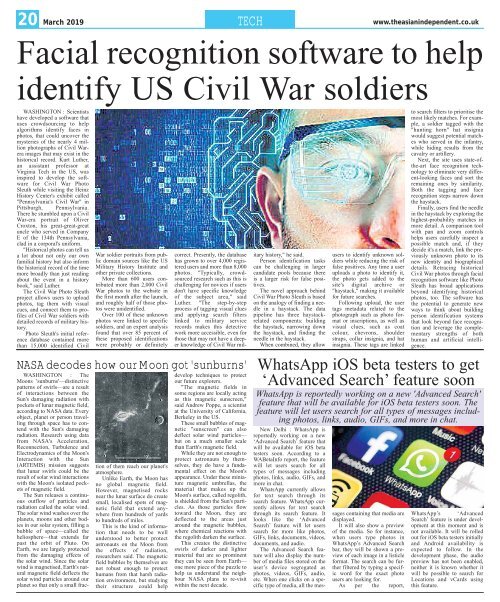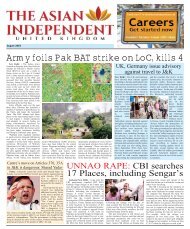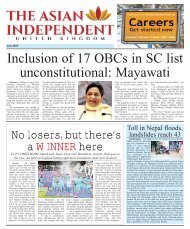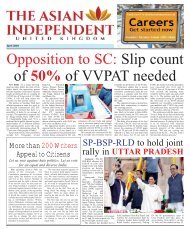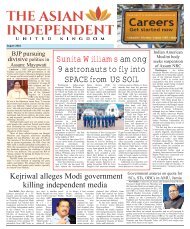March 2019
You also want an ePaper? Increase the reach of your titles
YUMPU automatically turns print PDFs into web optimized ePapers that Google loves.
20 <strong>March</strong> <strong>2019</strong><br />
TECH<br />
www.theasianindependent.co.uk<br />
Facial recognition software to help<br />
identify US Civil War soldiers<br />
WASHINGTON : Scientists<br />
have developed a software that<br />
uses crowdsourcing to help<br />
algorithms identify faces in<br />
photos, that could uncover the<br />
mysteries of the nearly 4 million<br />
photographs of Civil Warera<br />
images that may exist in the<br />
historical record. Kurt Luther,<br />
an assistant professor at<br />
Virginia Tech in the US, was<br />
inspired to develop the software<br />
for Civil War Photo<br />
Sleuth while visiting the Heinz<br />
History Center's exhibit called<br />
"Pennsylvania's Civil War" in<br />
Pittsburgh, Pennsylvania.<br />
There he stumbled upon a Civil<br />
War-era portrait of Oliver<br />
Croxton, his great-great-great<br />
uncle who served in Company<br />
E of the 134th Pennsylvania,<br />
clad in a corporal's uniform.<br />
"Historical photos can tell us<br />
a lot about not only our own<br />
familial history but also inform<br />
the historical record of the time<br />
more broadly than just reading<br />
about the event in a history<br />
book," said Luther.<br />
The Civil War Photo Sleuth<br />
project allows users to upload<br />
photos, tag them with visual<br />
cues, and connect them to profiles<br />
of Civil War soldiers with<br />
detailed records of military history.<br />
Photo Sleuth's initial reference<br />
database contained more<br />
than 15,000 identified Civil<br />
War soldier portraits from public<br />
domain sources like the US<br />
Military History Institute and<br />
other private collections.<br />
More than 600 users contributed<br />
more than 2,000 Civil<br />
War photos to the website in<br />
the first month after the launch,<br />
and roughly half of those photos<br />
were unidentified.<br />
Over 100 of these unknown<br />
photos were linked to specific<br />
soldiers, and an expert analysis<br />
found that over 85 percent of<br />
these proposed identifications<br />
were probably or definitely<br />
NASA decodes how our Moon got 'sunburns'<br />
WASHINGTON : The<br />
Moons 'sunburns'—distinctive<br />
patterns of swirls—are a result<br />
of interactions between the<br />
Sun's damaging radiation with<br />
pockets of lunar magnetic field,<br />
according to NASA data. Every<br />
object, planet or person travelling<br />
through space has to contend<br />
with the Sun's damaging<br />
radiation. Research using data<br />
from NASA's Acceleration,<br />
Reconnection, Turbulence and<br />
Electrodynamics of the Moon's<br />
Interaction with the Sun<br />
(ARTEMIS) mission suggests<br />
that lunar swirls could be the<br />
result of solar wind interactions<br />
with the Moon's isolated pockets<br />
of magnetic field.<br />
The Sun releases a continuous<br />
outflow of particles and<br />
radiation called the solar wind.<br />
The solar wind washes over the<br />
planets, moons and other bodies<br />
in our solar system, filling a<br />
bubble of space—called the<br />
heliosphere—that extends far<br />
past the orbit of Pluto. On<br />
Earth, we are largely protected<br />
from the damaging effects of<br />
the solar wind. Since the solar<br />
wind is magnetised, Earth's natural<br />
magnetic field deflects the<br />
solar wind particles around our<br />
planet so that only a small fraction<br />
of them reach our planet's<br />
atmosphere.<br />
Unlike Earth, the Moon has<br />
no global magnetic field.<br />
However, magnetised rocks<br />
near the lunar surface do create<br />
small, localised spots of magnetic<br />
field that extend anywhere<br />
from hundreds of yards<br />
to hundreds of miles.<br />
This is the kind of information<br />
that needs to be well<br />
understood to better protect<br />
astronauts on the Moon from<br />
the effects of radiation,<br />
researchers said. The magnetic<br />
field bubbles by themselves are<br />
not robust enough to protect<br />
humans from that harsh radiation<br />
environment, but studying<br />
their structure could help<br />
develop techniques to protect<br />
our future explorers.<br />
"The magnetic fields in<br />
some regions are locally acting<br />
as this magnetic sunscreen,"<br />
said Andrew Poppe, a scientist<br />
at the University of California,<br />
Berkeley in the US.<br />
These small bubbles of magnetic<br />
"sunscreen" can also<br />
deflect solar wind particles—<br />
but on a much smaller scale<br />
than Earth's magnetic field.<br />
While they are not enough to<br />
protect astronauts by themselves,<br />
they do have a fundamental<br />
effect on the Moon's<br />
appearance. Under these miniature<br />
magnetic umbrellas, the<br />
material that makes up the<br />
Moon's surface, called regolith,<br />
is shielded from the Sun's particles.<br />
As those particles flow<br />
toward the Moon, they are<br />
deflected to the areas just<br />
around the magnetic bubbles,<br />
where chemical reactions with<br />
the regolith darken the surface.<br />
This creates the distinctive<br />
swirls of darker and lighter<br />
material that are so prominent<br />
they can be seen from Earth—<br />
one more piece of the puzzle to<br />
help us understand the neighbour<br />
NASA plans to re-visit<br />
within the next decade.<br />
correct. Presently, the database<br />
has grown to over 4,000 registered<br />
users and more than 8,000<br />
photos. "Typically, crowdsourced<br />
research such as this is<br />
challenging for novices if users<br />
don't have specific knowledge<br />
of the subject area," said<br />
Luther. "The step-by-step<br />
process of tagging visual clues<br />
and applying search filters<br />
linked to military service<br />
records makes this detective<br />
work more accessible, even for<br />
those that may not have a deeper<br />
knowledge of Civil War military<br />
history," he said.<br />
Person identification tasks<br />
can be challenging in larger<br />
candidate pools because there<br />
is a larger risk for false positives.<br />
The novel approach behind<br />
Civil War Photo Sleuth is based<br />
on the analogy of finding a needle<br />
in a haystack. The data<br />
pipeline has three haystackrelated<br />
components: building<br />
the haystack, narrowing down<br />
the haystack, and finding the<br />
needle in the haystack.<br />
When combined, they allow<br />
users to identify unknown soldiers<br />
while reducing the risk of<br />
false positives. Any time a user<br />
uploads a photo to identify it,<br />
the photo gets added to the<br />
site's digital archive or<br />
"haystack," making it available<br />
for future searches.<br />
Following upload, the user<br />
tags metadata related to the<br />
photograph such as photo format<br />
or inscriptions, as well as<br />
visual clues, such as coat<br />
colour, chevrons, shoulder<br />
straps, collar insignia, and hat<br />
insignia. These tags are linked<br />
New Delhi : WhatsApp is<br />
reportedly working on a new<br />
‘Advanced Search’ feature that<br />
will be available for iOS beta<br />
testers soon. According to a<br />
WABetaInfo report, the feature<br />
will let users search for all<br />
types of messages including<br />
photos, links, audio, GIFs, and<br />
more in chat.<br />
WhatsApp currently allows<br />
for text search through its<br />
search feature. WhatsApp currently<br />
allows for text search<br />
through its search feature. It<br />
looks like the ‘Advanced<br />
Search’ feature will let users<br />
search for more like photos,<br />
GIFs, links, documents, videos,<br />
documents, and audio.<br />
The Advanced Search feature<br />
will also display the number<br />
of media files stored on the<br />
user’s device segregated as<br />
photos, videos, GIFs, audio,<br />
etc. When one clicks on a specific<br />
type of media, all the messages<br />
containing that media are<br />
displayed.<br />
It will also show a preview<br />
of the media. So for instance,<br />
when users type photos in<br />
WhatsApp’s Advanced Search<br />
bar, they will be shown a preview<br />
of each image in a listicle<br />
format. The search can be further<br />
filtered by typing a specific<br />
word for the exact photo<br />
users are looking for.<br />
As per the report,<br />
to search filters to prioritise the<br />
most likely matches. For example,<br />
a soldier tagged with the<br />
"hunting horn" hat insignia<br />
would suggest potential matches<br />
who served in the infantry,<br />
while hiding results from the<br />
cavalry or artillery.<br />
Next, the site uses state-ofthe-art<br />
face recognition technology<br />
to eliminate very different-looking<br />
faces and sort the<br />
remaining ones by similarity.<br />
Both the tagging and face<br />
recognition steps narrow down<br />
the haystack.<br />
Finally, users find the needle<br />
in the haystack by exploring the<br />
highest-probability matches in<br />
more detail. A comparison tool<br />
with pan and zoom controls<br />
helps users carefully inspect a<br />
possible match and, if they<br />
decide it's a match, link the previously<br />
unknown photo to its<br />
new identity and biographical<br />
details. Retracing historical<br />
Civil War photos through facial<br />
recognition software like Photo<br />
Sleuth has broad applications<br />
beyond identifying historical<br />
photos, too. The software has<br />
the potential to generate new<br />
ways to think about building<br />
person identification systems<br />
that look beyond face recognition<br />
and leverage the complementary<br />
strengths of both<br />
human and artificial intelligence.<br />
WhatsApp iOS beta testers to get<br />
‘Advanced Search’ feature soon<br />
WhatsApp is reportedly working on a new 'Advanced Search'<br />
feature that will be available for iOS beta testers soon. The<br />
feature will let users search for all types of messages including<br />
photos, links, audio, GIFs, and more in chat.<br />
WhatsApp’s ‘Advanced<br />
Search’ feature is under development<br />
at this moment and is<br />
not available. It will be rolled<br />
out for iOS beta testers initially<br />
and Android availability is<br />
expected to follow. In the<br />
development phase, the audio<br />
preview has not been enabled,<br />
neither it is known whether it<br />
will be possible to search for<br />
Locations and vCards using<br />
this feature.


